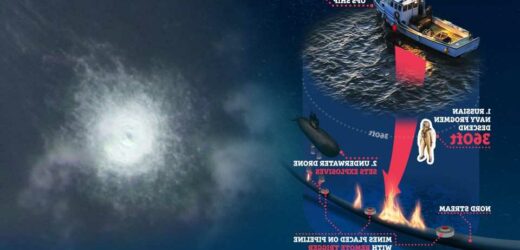A CRACK force of divers from a shadowy Russian special ops unit could be behind the attack on the Nord Stream gas pipeline, security experts have claimed.
Spetsnaz frogmen – a secretive branch of the Russian military – and underwater drones could have been deployed to blow up the strategically-important supply route.
Huge bubbles erupted on the sea surface near the Danish island of Bornholm – a NATO member – following reports of explosions along the pipeline on Monday.
Sweden confirmed they detected two underwater explosions near to the leak sites while German gas engineers reported there was an "explosive" pressure drop in the pipeline and the pipes have been "torn open".
Western leaders have accused Russia of sabotaging the line to stoke an energy crisis in Europe ahead of winter.
And according to an independent defence analyst, it's "not out of the question" to believe Moscow might have been behind downing thepipeline right under NATO's nose.
READ MORE ON WORLD NEWS
Stomach-churning moment Russian gets pal to ‘break’ leg to escape war draft
Zelensky defies Putin’s nuke threat as ‘99% vote to join Russia’ in sham referendum
Underwater warfare expert H I Sutton said Russia's shadowy GUGI naval unit, which is said to report directly to Vladimir Putin, may have used spy ships to carry out an attack.
The naval specialist said: "GUGI and the internet tapping subs. Today the Russian Navy has the largest fleet of spy submarines in the world. These are based in the arctic.
"They would be capable of damaging a pipe in the Baltic. However it seems improbable."
GUGI – the secretive Main Directorate of Deep Sea Research – has a mission to deliver a catastrophic blow to the West and is known to commandeer the navy's top vessels.
Most read in The Sun
Full I'm A Celebrity All Stars line up including soap icons & reality TV stars
England ace Alex Scott fell 'madly & deeply in love' with Kelly Smith
Putin feared to have SABOTAGED pipelines as the sea bubbles from gas leak
Major change to GP appointments as 'red alert' could see you turned away
H I Sutton also said the underwater supply channel was in 230ft of "divable" water that could be easily reached by professional divers who could then plant bombs.
"People will also point to Russian Spetsnaz divers based in Baltic. Not out of question, but much of the info out there is out of date," he explained.
He also said Russia housed a lab developing state-of-the-art underwater drones capable of carrying out deep-sea attacks.
He said: "Russia does however have autonomous underwater vehicles.
"A new center for their development is in St. Petersburg. Some of these might be suitable."
He added they would need a "host ship of some sort" to ferry them out.
Royal Danish Defence College researcher Anders Puck Nielsen echoed those concerns, saying that Putin's frogmen could easily hoist remote-controlled explosives onto the pipeline.
"Technically speaking, this is not difficult. It just requires a boat. It requires some divers that know how to handle explosive devices," he said.
"But I think if we look at who would actually benefit from disturbances, more chaos on the gas market in Europe, I think there's basically only one actor right now that actually benefits from more uncertainty, and that is Russia".
Another probable cause, according to a British military source, is that Russian special ops may have discreetly laid mines from a disguised commercial vessel and detonated them days or weeks later, according to The Guardian.
Just how the heavily fortified pipeline – which are coated in 25 tonnes of steel-reinforced concrete and weigh 11 tonnes each – burst remains unclear at the meantime.
Ukraine accused Russia of carrying out a "terror attack" after three leaks appeared in the two strategic pipes which run beneath the Baltic Sea.
Poland's prime minister Mateusz Morawiecki said it was an "act of sabotage" while his Danish and Swedish counterparts viewed the leaks as "deliberate actions".
Sweden's PM Magdalena Andersson said intelligence she received suggests the blasts were intentional.
"We have Swedish intelligence, but we have also received information in our contacts with Denmark, and based on this concluded that this is probably a deliberate act. It is probably a matter of sabotage," she said.
"It is not a matter of an attack on Swedish or Danish territory. But that said, the government is taking what happened very seriously, not the least in light of the current security situation on our close proximity."
Meanwhile, it's emerged that CIA reportedly warned Germany of a possible attack on the Nord Stream pipelines weeks ago, according to Der Spiegel.
Swedish seismologist Bjorn Lund detected a blast with the force of 100kgs of TNT – and Norwegian monitoring group Norsar registered an earthquake of around magnitude 2.2.
Mr Lund said he had detected two explosions close to the pipeline on Monday, one at 2am and another at 7.04pm.
"There is no doubt that these were explosions," he said.
Nord Stream AG – the pipeline's operator – said it was impossible to estimate when the gas network would be fixed.
Flows via the pipeline, which had been working at only 20 per cent of capacity since July, were halted at the end of August.
Russia's state owned oil and gas company Gazprom said it needed essential maintenance, but then did not reopen the line.
European leaders said the shutdown was nakedly political as Putin tries to hold the West to ransom over its support for Kyiv.
While the apparent sabotage won't immediately impact supply, it has sent prices soaring by up to 12 per cent, reports Bloomberg.
Ships and planes have been told to stay way with an exclusion zone of five nautical miles and 1,000 metres altitude set up around the leaks due to fears of a disastrous explosion.
Read More on The Sun
People are only just realising they’ve been using bubble wands wrong
Kate Middleton swears by a £6 product to stop her shoes from slipping
Danish warship HDMS Absalon – a 6,300 ton frigate armed with missiles and a five-inch naval gun – has been deployed to enforce the exclusion zone.
The twin 800-mile pipelines Nord Stream 1 and Nord Stream 2 can ferry 110billion cubic metres of gas annually from Russia into Western Europe.
Source: Read Full Article
















